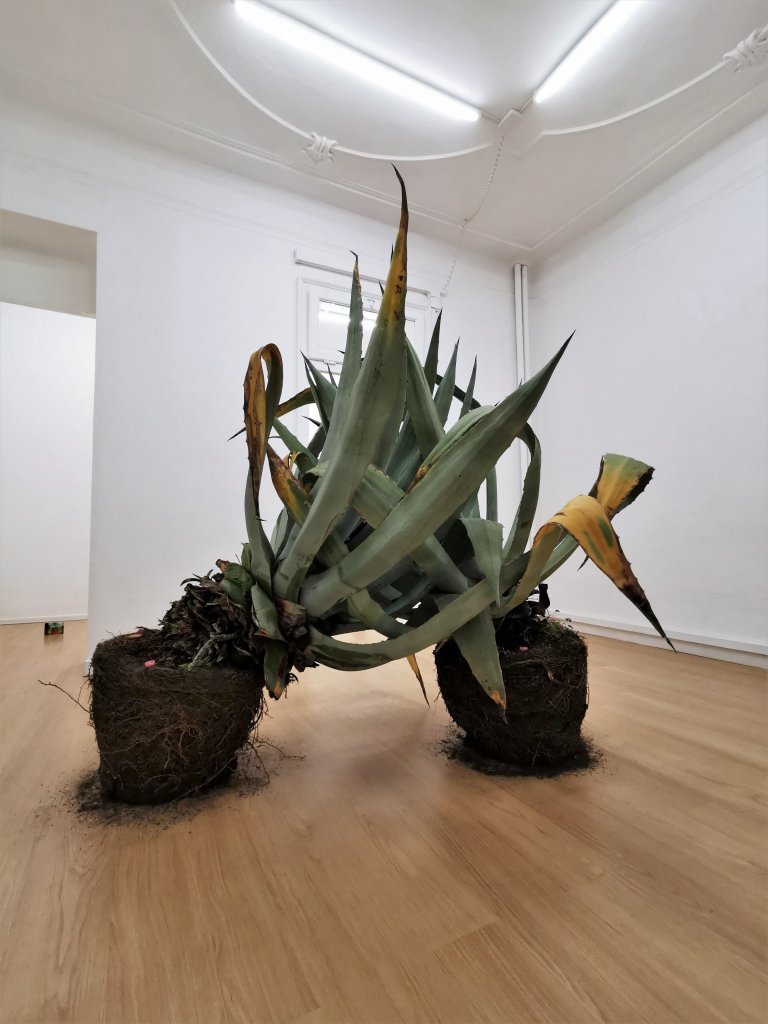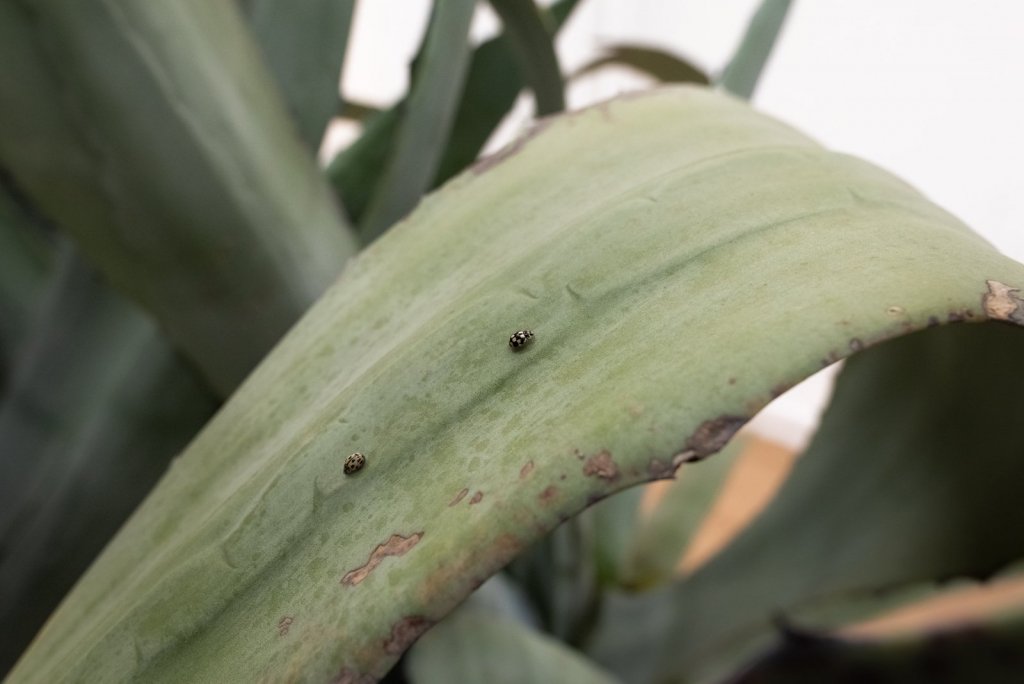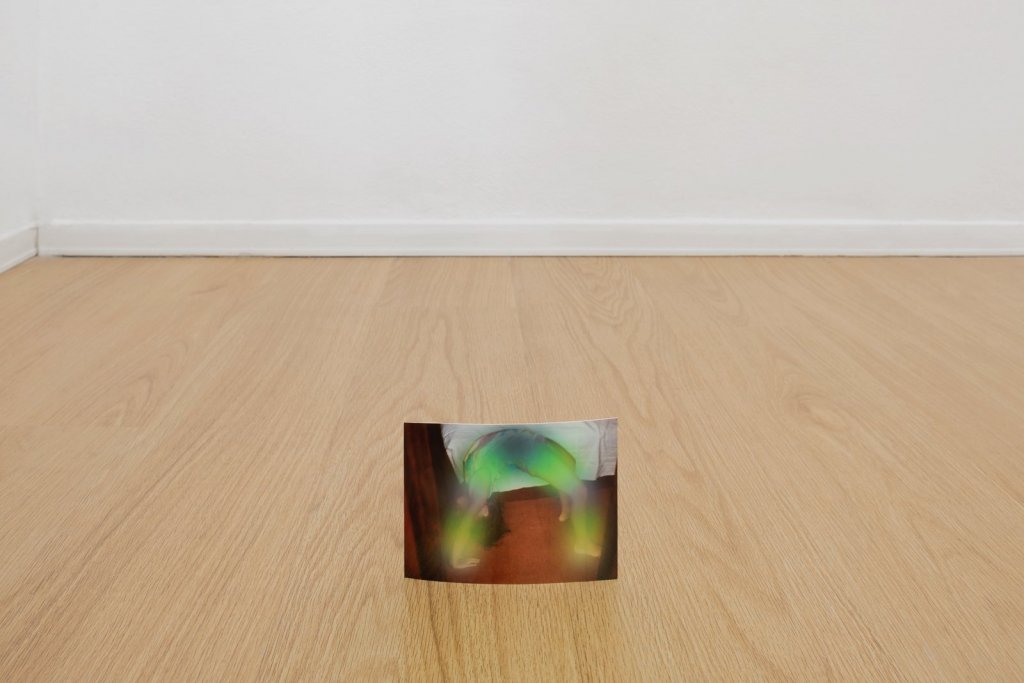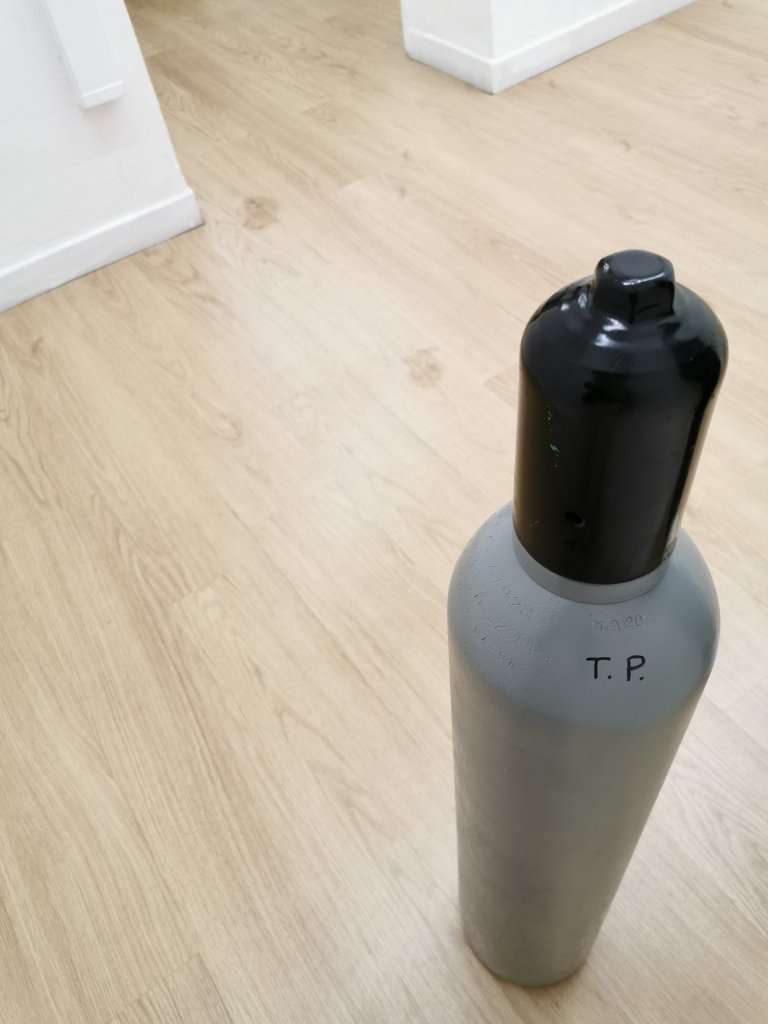Lisa Dalfino & Sacha Kanah, living and non-living beings
Introduction to the work of Lisa Dalfino and Sacha Kanah starting from their second solo exhibition at Clima gallery in Milan.
Anyone wishing to look at the work of Lisa Dalfino and Sacha Kanah with the attention it deserves should certainly know that the two placid agaves that are standing inside Clima gallery in Milan are actually sisters and come from the collection of succulent plants of a man from Vicenza. In the summer of 1985, the man had taken two suckers from the mother plant and had transplanted them in the garden of his house. Over the years the two small creatures have grown to their present size, and have reproduced. But then that man got sick, and his sons needed to get rid of the two ‘monsters’, as Sacha Kanah calls them. The artist told us this story via Skype, since in these days neither he nor we can leave the house. That’s how the two agaves ended up hugging each other (can you imagine two agaves arguing with each other?) in the main room of a contemporary art gallery, a room that the lazy sisters are sharing with a colony of 100 living ladybugs, with a picture of a little girl’s aura, and with a CO2 tank – then we’ll see what it stands for.

This story represents a still hidden side of Lisa Dalfino and Sacha Kanah’s new body of works, since the exhibition currently at Clima gallery has not been provided with any introductory text. But this is where we shall possibly start from. The visual metaphor that the two embraced plants represent has a very specific nature and responds to a broader discourse than the one a mere glance could suggest. “We are interested in the relationship between artificial infrastructures and the creatures that live around or within them” Sacha Kanah tells us. The agaves are in fact a living sculpture. The ladybugs buzzing in the room are also living sculptures, and like the agaves they need someone to take care of them. Even the photo of an aura needs a human being to be taken, and the same goes for the carbon dioxide sculpture to be properly used. That’s what the cylinder is for: someone has to ‘shoot’ the carbon dioxide inside the shell that will shape the gas until that ‘shell’ is broken. Then the sculpture will live in the exhibition space, for a brief moment, before the gas is lost in the air..
Our constructions are ‘nature’ because as human beings we are also ‘nature’ (that is a reinterpretation of the concept of ‘artificiality’) and as such we co-evolve; the other species permeate where we let our guard down. It is an exercise in surrender, in opposition to the strategies of fear with which we are forced to confront ourselves in everyday life. Liberated from their embankment, these agaves face the gallery space, slowly taking possession of it, heading towards gaps and cracks to enter the load-bearing walls (Clima’s walls are ‘sacked’, i.e. with a cavity filled with sand, clay and crumbled floors) and become a structure. The bond grows inextricable, otherwise the architecture will collapse. It is a re-balanced relationship with the entities that surround us; it’s the end of an ‘apartheid’. In Hong Kong there are 10,000 trees growing spontaneously in the city’s retaining walls: they can’t cut them down or the walls will collapse.


Each of these four metaphors is deeply consistent with a topic which, as we have said, is that of life and the way it ‘crosses’ artificial structures and infrastructures. Rather than the obvious discourse on the nature of the object, in the background is the quantum entanglement theory, and how the interweaving of res extensa and res cogitans can become artistic expression – the gases, the aura, the forms of plants and animals, the narrative itself, with its characters.
In the other room there is a gold string of the calibre of a few microns hanging from the ceiling. The work is practically imperceptible. It only appears when the angle of incidence of light makes the metal shine. Or alternatively you can see the work if someone who knows where it is shows it to you. This is another metaphor, but it is not about the continuity between material and immaterial; rather it’s about the revelation that the act of creating a work of art nurtures in itself. Also in this case human interaction is needed, this exchange is a constant for the work of art to take place. The string provides for an exchange.
What science offers us is a mere glimpse. What science does, instead, is to make a certain way of thinking monolithic. Instead, we are interested in deviations. The things we see at this moment are the outcome of a long cultural process. But things could have gone differently. So we try to walk other directions, following the intelligence of the matter, and trying to guide it without ever touching it.

For Lisa Dalfino and Sacha Kanah ‘driving without touching’ means writing, that is, weaving the fabric of ideas on which the works then rest, like planets of a great system of balanced forces. Obviously that fabric is invisible. The two authors do not write with the aim of producing texts to be published, but in order to ‘actively understand’ their work. It is in fact important, they say, that the work can be expressed verbally with sufficient clarity. Artistic work is verified by writing, and the problems that arise from its creation are dealt with accordingly. Indeed, ‘Everything has to add up,’ says Kanah, like in a musical score, a screenplay, or a great architectural project.
At this point it may be useful to have some biographical details. Sacha Kanah graduated in architecture, after doing plenty of other things (including the driver, the printer, the beekeeper, the fashion photographer). Lisa Dalfino studied at the Brera Academy, where she was a pupil of Alberto Garutti.
Sacha Kanah and Lisa Dalfino are not a couple in life. They met at Brera, which Sacha also attended for a certain period of time. But instead of Garutti, the contemporary masters to whom we think their work could refer to are Olafur Eliasson and Tobias Rehberger (who are also excellent teachers). Of the former they share a similar interest for science and the tendency to produce works, as Winckelmann would say, of noble simplicity and quiet grandeur – even when they are in small format (see the stair acquired in 2018 by the Fondazione Fiera Milano (i.e. MiArt). Of Rehberger, on the other hand, they recall the destructuring transversal in the use of ‘semi-finished’ materials. Of both these contemporary masters they also share a potential that in the case of Sacha Kanah and Lisa Dalfino is still unexpressed: that of projecting artistic work into the dimension of architecture.
May 17, 2020
